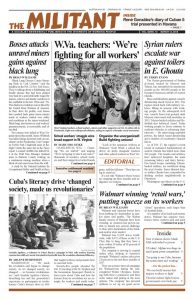Common Pleas Court Judge Kathryn Lewis reinstated criminal charges Feb. 6 against Brandon Bostian, the engineer who was driving Amtrak Train 188 that crashed May 12, 2015, in Philadelphia. Eight people died and 200 were injured when the Washington-to-New York train rounded a curve at more than twice the 50 mph speed limit and derailed.
Rail bosses and capitalist politicians have tried to blame Bostian and divert attention from the real culprits — the disregard for safety by the bosses and their government, including their continual efforts to slash crew sizes in search of higher profits. But from the beginning they have had difficulty making their frame-up stick, as Bostian was well respected among co-workers for working safely, and government investigators admit Bostian hadn’t used drugs or alcohol, and wasn’t on his cellphone.
The Philadelphia District Attorney’s Office refused to bring charges, saying there was no evidence of criminal intent. Just days before the statute of limitations ran out, the Pennsylvania Attorney General’s Office stepped in and filed frame-up charges against Bostian, including 200 counts of reckless endangerment, eight counts of involuntary manslaughter and one of “causing or risking a catastrophe.”
Municipal Court Judge Thomas Gehret dismissed the charges in September 2017, saying he also saw no evidence Bostian acted with criminal intent. Lewis overruled the decision.
A National Transportation Safety Board report after the crash said Bostian likely had been distracted by reports on his radio about a nearby train that was forced to stop after vandals smashed its windshield with a rock, injuring the engineer.
When the government-funded passenger line was created in the 1970s, a minimum two-person crew was required in each Amtrak locomotive. But since 1983, over the objection of the rail unions, Amtrak began running its Northeast Corridor trains with a locomotive crew of just one engineer.
Rail workers and their union protested the efforts to frame up Bostian for the accident. If a second engineer had been in the cab to assist him “in managing the multiple tasks confronting him, there would have been no accident,” Dennis Pierce, president of the Brotherhood of Locomotive Engineers and Trainmen, said in a 2016 statement.
The Transportation Safety Board dismissed the union’s view.
Three years since the crash, Amtrak — like most passenger and freight railroads — still runs its trains with just one engineer.
At the time of the 2015 crash, Amtrak had what is known as “positive train control” on the southbound tracks leading into the deadly curve, but not the northbound one that Bostian’s train was on. The system is designed to slow down and stop any train that is going above the posted speed. Since the accident, the northbound control system was activated.
There has been a string of recent Amtrak derailments, with deadly consequences. An Amtrak train on the way to Florida Feb. 4 was shunted onto the wrong track and crashed into a freight train in South Carolina, killing two — the engineer and a train conductor — and injuring 116. Amtrak’s inaugural run on new track in Washington state from Tacoma to Portland, Oregon, derailed and crashed at high speed Dec. 18, with three killed and over 100 hurt.

